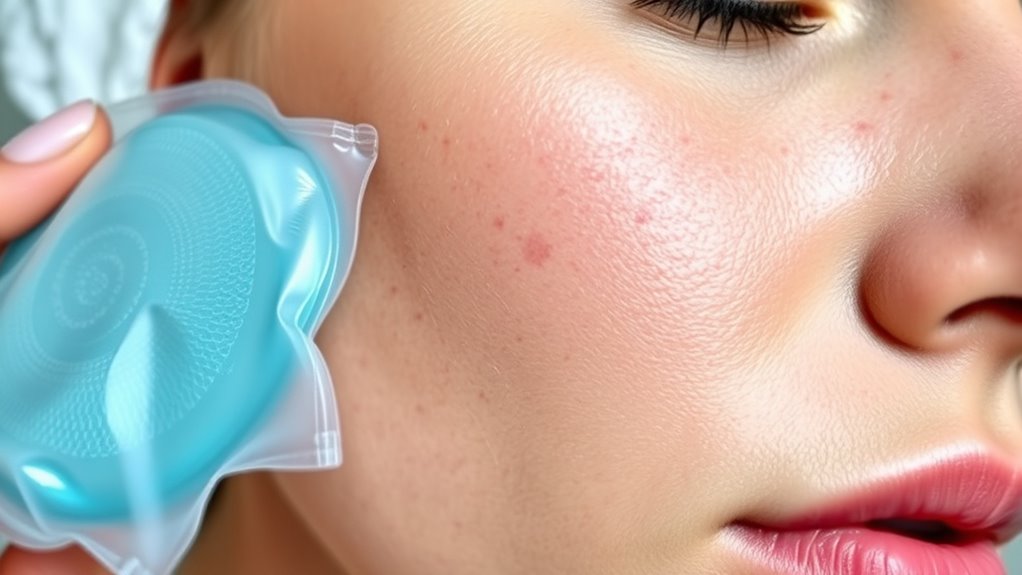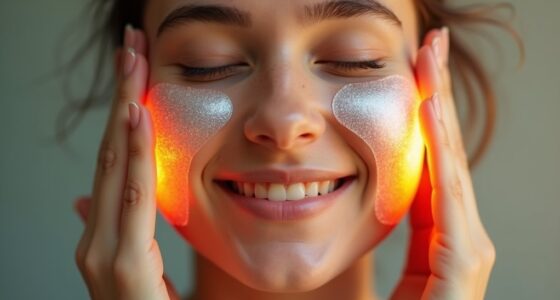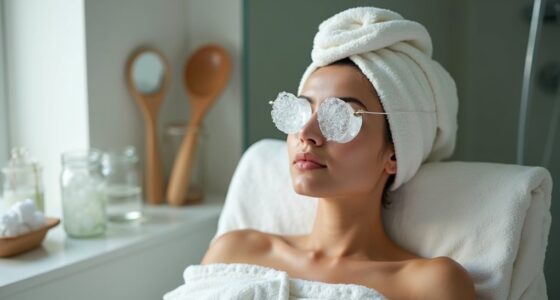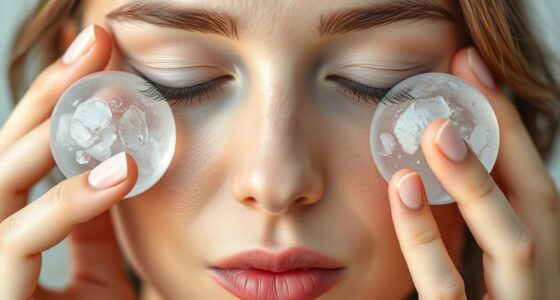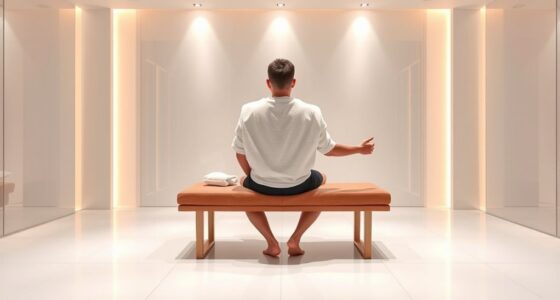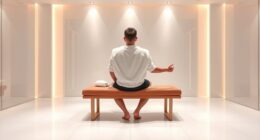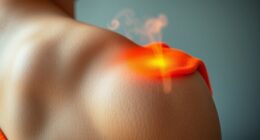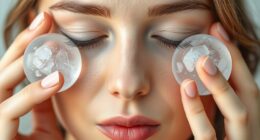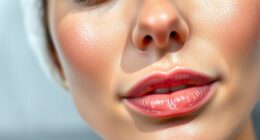Cold therapy is a natural way to soothe your skin and reduce acne, redness, and inflammation. By applying a cold compress or ice wrapped in a cloth, you constrict blood vessels and calm irritation. This method helps minimize swelling and tightens pores quickly. For best results, use it regularly but carefully to avoid irritation. If you want to discover more tips on making cold therapy work for your skin, keep exploring how to incorporate it into your routine.
Key Takeaways
- Cold therapy reduces acne and redness by calming irritation and constricting blood vessels.
- Applying cold compresses or ice packs gently soothes skin without causing damage.
- Regular use helps diminish inflammation, swelling, and tightens pores for clearer skin.
- Cold therapy works best when combined with natural remedies like herbal toners or aloe vera.
- Precautions include avoiding prolonged exposure to prevent frostbite and consulting dermatologists if needed.
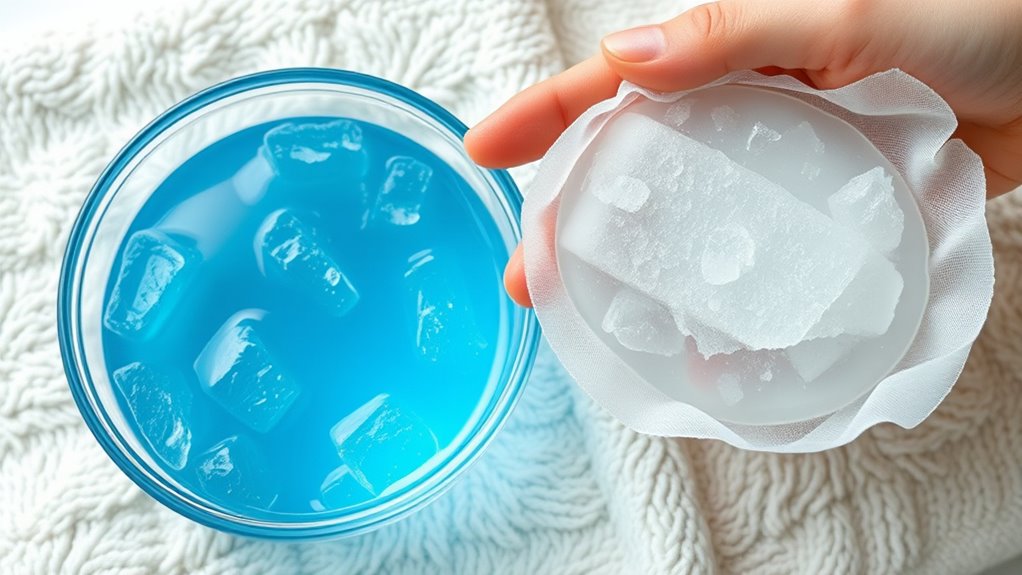
Cold therapy is a simple, effective way to reduce acne and redness. When you apply cold to your skin, it helps constrict blood vessels, which in turn minimizes inflammation and calms irritation. This makes it a popular choice for those seeking quick relief from flare-ups and redness. Many people turn to natural remedies, including cold therapy, because they want to avoid harsh chemicals and opt for gentle, non-invasive treatments. Incorporating cold therapy into your skincare routines isn’t complicated, and it can provide immediate soothing benefits, especially when combined with other natural remedies like aloe vera or tea tree oil.
Cold therapy reduces acne and redness naturally by calming irritation and constricting blood vessels.
To start, you can use a cold compress or an ice pack wrapped in a soft cloth. Applying it directly to affected areas for a few minutes helps reduce swelling and tightens pores, which can help prevent future breakouts. Just be sure not to leave the cold on your skin for too long, as prolonged exposure can cause frostbite or irritation. Ideally, a few minutes at a time is enough to get the benefits without risking damage. You might also try alternative methods like a chilled spoon or a cold, damp cloth for a more gentle approach, especially if you have sensitive skin.
Incorporating cold therapy into your skincare routines is straightforward. You can do it as a quick step before applying serums or moisturizers, or as a calming treatment after cleansing. Regular use can help keep redness at bay and promote a healthier skin appearance over time. Keep in mind that consistency is key; making cold therapy a part of your daily or weekly routine maximizes its benefits. It’s also worth noting that cold therapy complements other natural remedies, like using soothing herbal toners or gentle exfoliants, to create a balanced skincare approach.
When you combine cold therapy with a healthy skincare routine, you’re actively supporting your skin’s healing process. You’ll likely notice that redness diminishes faster, and your skin feels calmer and less inflamed. Additionally, understanding the cultural impact of technology on artistic expression can help you appreciate how modern innovations influence natural and creative approaches to skincare. Always pay attention to how your skin reacts, and if you have underlying skin conditions, consult a dermatologist before making significant changes. Cold therapy isn’t a cure-all, but it’s a simple, accessible tool to help you manage acne and redness naturally. With patience and proper application, you can enjoy clearer, calmer skin without relying solely on topical medications.
Frequently Asked Questions
How Often Should I Use Cold Therapy for Best Results?
You should use cold therapy 2-3 times a week for the best results. Follow the frequency guidelines to avoid overdoing it, which can irritate your skin. Each session should last about 5-10 minutes, depending on your skin’s sensitivity. Make sure to listen to your skin and adjust the session duration if you notice any redness or discomfort. Consistency is key for effective acne and redness reduction.
Can Cold Therapy Be Combined With Other Acne Treatments?
You can definitely combine cold therapy with other acne treatments, as it often works well as part of a broader skincare routine. Think of cold therapy as a complementary treatment that reduces inflammation, making your other products more effective. Just make certain you’re using gentle, non-irritating products alongside it. This combination skincare approach helps manage breakouts and redness more effectively, giving you clearer, calmer skin faster.
Are There Any Risks or Side Effects From Cold Therapy?
Cold therapy is generally safe, but you should be aware of potential skin irritation and frostbite risk if used improperly. You might experience redness, numbness, or discomfort if the cold temperature is too intense or applied for too long. Always use a barrier like a cloth and limit application time to avoid damaging your skin. If any adverse effects occur, stop immediately and consult a healthcare professional.
How Long Should Each Cold Therapy Session Last?
Did you know that cold therapy sessions are most effective when kept between 10 to 15 minutes? You should follow these duration guidelines to avoid skin irritation. Typically, you can perform cold therapy 1-3 times daily, depending on your skin’s sensitivity and the severity of redness or acne. Always listen to your skin and adjust session frequency accordingly to maximize benefits while minimizing risks.
Is Cold Therapy Suitable for All Skin Types?
Cold therapy isn’t suitable for all skin types, especially if you have sensitive skin. If your skin sensitivity is high, it might cause irritation or redness. Always check product compatibility before use, and do a patch test first. If you experience discomfort or adverse reactions, stop immediately. Consult a dermatologist if you’re unsure whether cold therapy suits your skin type or if you have underlying skin conditions.
Conclusion
You might think cold therapy is just a quick fix, but it genuinely reduces inflammation and calms redness, making your skin look clearer. Some believe it even shrinks pores over time, though more research is needed. While it’s not a miracle cure, incorporating cold therapy into your routine could help you manage acne and redness naturally. Give it a try—you might find it’s a simple, effective way to soothe your skin and boost your confidence.
